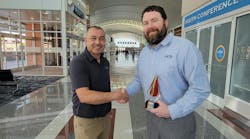The nation's airline industry is a shoulder-launched missile attack away from plunging into a financial tailspin, one that could trigger $1 trillion-plus in financial losses in this country.
Five years after the devastating attacks of Sept. 11, 2001, U.S. passenger jets still have no response to a shoulder-launched missile that can be purchased on the black market for as little as $5,000 and can hit a target more than a mile away. If beefed-up airline security continues to keep terrorists and their bombs off commercial flights, shoulder-launched missile attacks pose a likely alternative, experts say.
"Terrorists are a lot like electricity: They take the path of least resistance," said Jack Pledger, an executive at defense contractor Northrop Grumman Corp. "Instead of working out elaborate methods, terrorists go to the next-easiest thing. If you take out these easy things, you drive them to using" a shoulder-launched missile.
Pledger is director of business development for Northrop Grumman's infrared-countermeasure program, which is testing a system that disrupts a shoulder-launched missile's guidance system. The cost of the system would be less than $1 million for each plane if Northrop were to receive enough orders to warrant high-rate production.
But the U.S. government and the airline industry are not ready to spend the billions of dollars it would take to equip passenger jets with anti-missile systems. And even if an initiative started today, it would take several years to equip the several thousand passenger jets operated by the U.S. airlines.
The unaddressed threat underscores the physical and financial vulnerability of U.S. airlines, despite massive efforts by the government and industry to prevent hijackings and scary episodes like the thwarted plot in Great Britain that targeted U.S.-bound commercial flights with liquid explosives.
Last year, a study by think tank RAND Corp. warned that as measures are taken to preclude Sept. 11-style attacks -- including better screening of passengers and luggage -- groups like al-Qaida may resort to shoulder-launched missiles because of the obvious vulnerability.
A missile attack on a passenger jet would produce the same spectacular result that al-Qaida plotters sought recently in Great Britain. Authorities there foiled plans to blow up U.S.-bound planes with liquid explosives smuggled in drink bottles.
The airline industry isn't in financial position to afford anti-missile systems. Roiled by sky-high prices for fuel, bankruptcy filings and debt-laden balance sheets, the industry remains fragile.
Pledger said the industry is waiting for Congress to fund the sort of anti-missile system being tested by Northrop Grumman.
"There's not really a market" from commercial airlines, Pledger said. "The carriers are interested in the systems, but they see the protection as a government responsibility."
It would cost an estimated $11 billion to equip 6,800 U.S. commercial jets with anti-missile systems, not including annual operating costs of more than $2 billion, according to government estimates.
But that may be a bargain when you consider the financial reverberations that shook the U.S. after the attacks on the World Trade Center and the Pentagon.
Copyright 2005 LexisNexis, a division of Reed Elsevier Inc. All rights reserved.
Terms and Conditions | Privacy Policy
News stories provided by third parties are not edited by "Site Publication" staff. For suggestions and comments, please click the Contact link at the bottom of this page.





